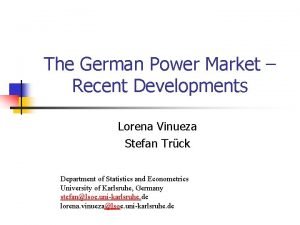Unprecedented Manmade Trends in Ocean Acidity T Friedrich

- Slides: 1

Unprecedented, Man-made Trends in Ocean Acidity T. Friedrich and A. Timmermann (IPRC); A. Abe-Ouchi and M. O. Chikamoto (JAMSTEC), et al. , Nature Climate Change, March 2012 . Upper panel: Simulated surface aragonite saturation. Lower panel: Simulated atmospheric CO 2 concentration in parts per million The man-made CO 2 signal in the ocean has been difficult to detect because seawater p. H varies seasonally, annually and regionally, making for much “natural noise”, and because continuous ocean chemistry observations go back at most 30 years. By using three Earth System models (MPI, LOVECLIM, MIROC), IPRC’s Tobias Friedrich and Axel Timmermann with an international team of climate modelers, marine conservationists, ocean chemists, biologists, and ecologists, have traced changes in aragonite surface saturation level (a common measure of ocean acidity) 21 thousand years back in time and into the future to the end of this century. They conclude that the surface aragonite saturation levels are currently decreasing at a rate about 10 to 100 times faster than at any time during the Last Glacial Termination, and that the anthropogenic CO 2 emissions over the last 100 years have pushed ocean acidity far above the range that prevailed during those earlier times. Coral reefs live in places where open-ocean aragonite surface saturation reaches 3. 5 units or higher. Such conditions exist today in about 50% of the global ocean – mostly in the tropics. By end of the 21 st century the MPI simulation projects that such levels of aragonite saturation will occur in less than 5% of the ocean.

